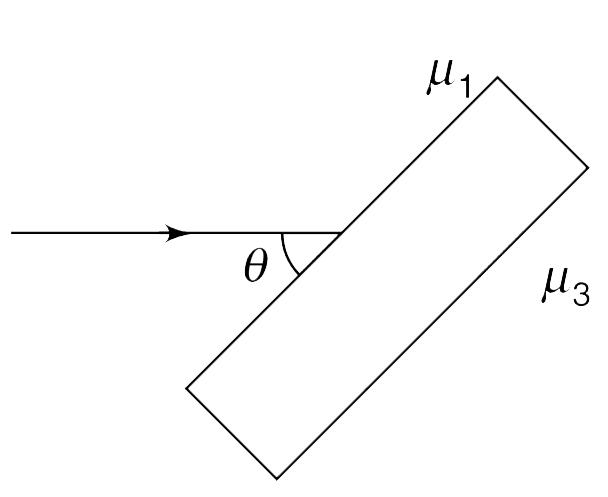Find the angle of refraction in a medium (μ=2) if light is incident in vacuum, making an angle equal to twice the critical angle.
sin−1(√34)
sin−1(√32)
sin−1(12)
sin−1(2)
The correct Answer is:A
To find the angle of refraction in a medium with a refractive index of μ=2 when light is incident from a vacuum at an angle equal to twice the critical angle, we can follow these steps:
Step 1: Calculate the Critical Angle
The critical angle θc can be found using Snell's law at the boundary between two media, where the light goes from a medium with a higher refractive index to a lower one. The formula is:
μ1sin(θc)=μ2sin(90∘)
Here, μ1=2 (the refractive index of the medium) and μ2=1 (the refractive index of vacuum). Therefore, we have:
2sin(θc)=1
This simplifies to:
sin(θc)=12
Taking the inverse sine gives us:
θc=sin−1(12)=30∘
Step 2: Determine the Incident Angle
The problem states that the incident angle θ1 is twice the critical angle:
θ1=2×θc=2×30∘=60∘
Step 3: Apply Snell's Law
Now we apply Snell's law to find the angle of refraction θ2:
μ1sin(θ1)=μ2sin(θ2)
Substituting the known values:
2sin(60∘)=1sin(θ2)
Calculating sin(60∘):
sin(60∘)=√32
Thus, we have:
2⋅√32=sin(θ2)
This simplifies to:
√3=sin(θ2)
Step 4: Find the Angle of Refraction
To find θ2, we take the inverse sine:
θ2=sin−1(√3)
However, since √3 is greater than 1, this means that the angle of refraction is not possible in this case, indicating total internal reflection occurs.
Conclusion
Thus, the angle of refraction cannot be determined as light does not refract into the medium when the incident angle is greater than the critical angle.
---
The critical angle θc can be found using Snell's law at the boundary between two media, where the light goes from a medium with a higher refractive index to a lower one. The formula is:
The problem states that the incident angle θ1 is twice the critical angle:
Now we apply Snell's law to find the angle of refraction θ2:
To find θ2, we take the inverse sine:
Thus, the angle of refraction cannot be determined as light does not refract into the medium when the incident angle is greater than the critical angle.
Topper's Solved these Questions
- BOOK - CENGAGE PHYSICSCHAPTER - GEOMETRICAL OPTICSEXERCISE - Solved Examples15videos
GEOMETRICAL OPTICS
- BOOK - CENGAGE PHYSICSCHAPTER - GEOMETRICAL OPTICSEXERCISE - Exercise1.114videos
GEOMETRICAL OPTICS
- BOOK - CENGAGE PHYSICSCHAPTER - FRICTIONEXERCISE - QUESTION BANK1videos
FRICTION
- BOOK - CENGAGE PHYSICSCHAPTER - GRAVITATIONEXERCISE - Question Bank39videos
GRAVITATION
Similar Questions
The refractive index of a medium is √3. What is the angle of refraction, if the unpolarised light is incident on it at the polarising angle of the medium ?
View SolutionA light ray travelling in a medium of refractive index μ1 is incident on a parallel faced glass slab making an angle of θ with the glass surface. The refractive index of the medium on the other side of the glass slab is μ3(>μ1). Find the angular deviation suffered by the light ray.
 View Solution
View Solution
Knowledge Check
- Question 1 - Select One
If angle of incidence is twice the angle of refraction in a medium of refractive index μ , then angle of incidence is
A2cos−1μ2B2sin−1μ2C2cos−1μD2sin−1μ - Question 2 - Select One
In total internal reflection when the angle of incidence is equal to the critical angle for the pair of medium in contact, what will be angle of refraction? In total internal reflection when the angle of incidence is equal to the critical angle for the pair of medium in contact, what will be angle of refraction? In total internal reflection when the angle of incidence is equal to the critical angle for the pair of medium in contact, what will be angle of refraction?
A90∘B180∘C0∘Dequal to angle of incidence - Question 3 - Select One
Find the maximum angle that can be made in glass medium (μ=1.5) if a light ray is refreacted from glass to vacuum.
Asin−14/3Bsin−12/3Csin−11/3Dsin−15/3
The refractive index of a medium is √3. What is the angle of refraction, if unpolarizing light is incident on the polarising angle of the medium ?
View SolutionA ray of light passes through a plane boundary separating two media whose refractive indics are μ1=3/2 and μ2=4/3. (i) If the ray travels from medium 1 to medium 2 at an angle of incidence of 30∘, what is the angle of refraction ? (ii) If the ray travels form medium 2 to medium 1 at the same angle of incidence, what is the angle of refraction ?
View SolutionWhat is meant by the 'angle of incidence' and the 'angle of refraction' for a ray of light? Draw a labelled ray diagram to show the angle of incidence and the angle of refraction for a refracted ray of light.
View SolutionFind the polarising angle and the angle of refraction in glass if the critical angle for a certain wavelength of light in glass is 40∘.
View SolutionWhich of the following statement is / are correct about the refraction of light from a plane surface when light rays is incident in denser medium. [ C is critical angle ]
View Solution

